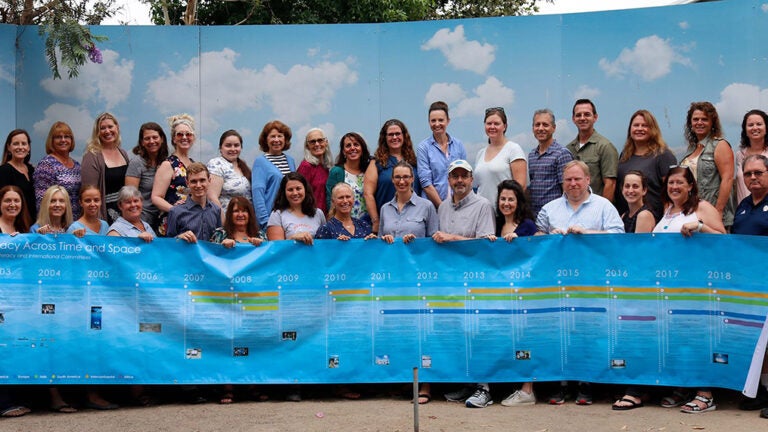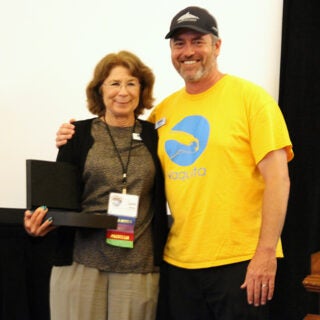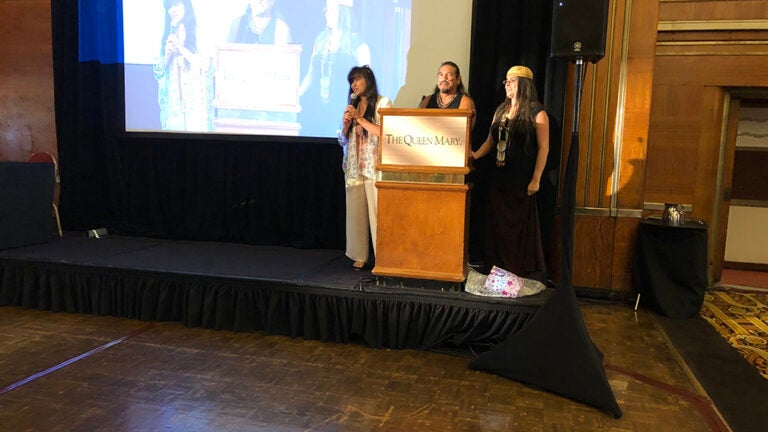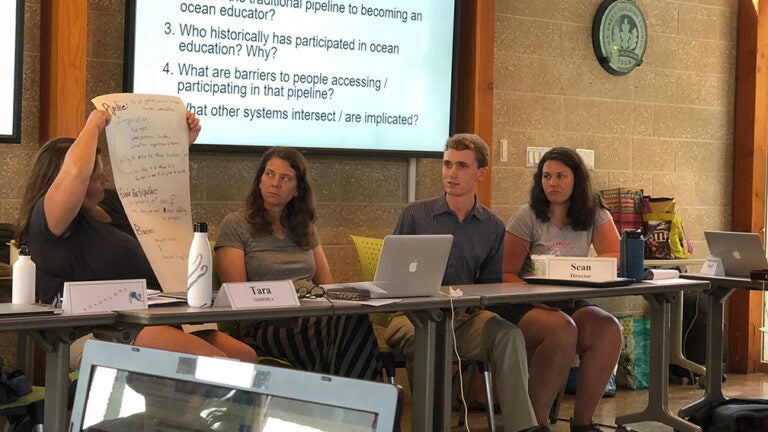
NMEA board with a banner celebrating ocean literacy across time and space
Charting a Course for Conservation
The 2018 National Marine Educators Association (NMEA) conference was held July 15-20 in Long Beach aboard the Queen Mary. This annual conference provided a wealth of opportunities to share work, spark new ideas, and build collaborations. As a NMEA board member, it was a pleasure to help plan this year’s conference. The board’s annual meeting during the conference focused discussions on the challenges of increasing diversity in marine education and sciences. Keynote speakers challenged us to address marine conservation issues including the risk of vanishing Vaquita. Featured speakers Mati Waiya, Chumash elder and founder and executive director of Wishtoyo Chumash Foundation, and Alicia Cordero, Island Chumash and First Nations Program officer, provided tremendous insight to think more deeply and to create safer spaces for all youth and to live in a better relationship with Earth.

This year’s prestigious Marine Educator’s Award recipient was Lynn Whitley, director of pre-college education for the USC Wrigley Institute (and former education coordinator for USC Sea Grant), recognizing more than 20 years of her work in marine education, congratulations!
This conference provided a wonderful opportunity to expand knowledge and networking opportunities for four of our LA California Coastal Naturalists and for three of our past High School Summer Marine Lab participants, Johanna, Jessika and Lillianna, who attended the youth day of the conference.
The Sea Grant Education Network also met to share ideas and new work, and Chris Petrone of Delaware Sea Grant led a Strategic Doing work session focused on implementation of the 10-YEar NOAA Sea Grant Environmental Literacy Vision Plan.
The final day was devoted to fieldtrips throughout the region (photos below) and as we headed home we also head off to continue our work and build upon our relationships with the ocean and one another.


Group Field Trip: Seal Beach National Wildlife Refuge
One group field trip traveled to the Seal Beach National Wildlife Refuge with NWR manager Rick Nye and CSULB researcher Dr. Christine Whitcraft to learn about protecting the wetlands from sea level rise and to release 11 Ridgway Rail chicks. The group was treated to a tour of the Nature Center and a lecture on the history of the Naval Base and the Seal Beach National Wildlife Refuge. The group took a tour of the marsh and saw shore birds, raptures, the endangered Savannah Sparrow, crabs, lots of pickle weed and cord grass, and the hand-made Ridgway Rail nests. Volunteers at the refuge make the nests to help the Ridgway breed because the cord grass is not tall enough for them to make the nests themselves. The Refuge hopes that one day fresh water will be returned to the marsh so that the cord grass can grow tall enough for the Ridgway to make their nests once again.
The group saw four green sea turtles who came down the San Gabriel River to feast on eel grass in ponds at the refuge. One of the highlights of the field trip was assisting DFG to band and release 11 endangered Ridgway Rails into the marsh. This only happens once every 5 years, so the group was very excited that it coincided with the trip. There are only 800 individuals left in the wild so this was a significant addition to the population!
Group Field Trip: NOAA Southwest Fisheries Science Center
One group field trip headed to La Jolla and the NOAA Southwest Fisheries Science Center under the guidance of Dr. Sarah Mesnik and met with Dr. Mike Shane at the Leon Hubbard fish hatchery center to explore where aquaculture and technology intersect to better understand our ocean.
Group Field Trip: Crystal Cove Conservancy
One group field trip headed to Newport Beach with the Crystal Cove Conservancy and Davey’s Locker who took folks out to participate in a floating lab – including digital fishing and plankton identification – within the marine protected area. Dolphins showed up to round out the boat trip and then the group met Robin Madrid and her staff at Back Bay Science Center to learn about the critical role of wetlands and the work being done by Department of Fish and Wildlife.















